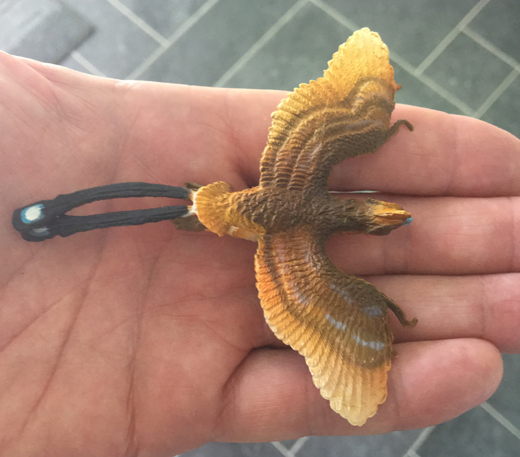Archaeopteryx and Confuciusornithids Not Flyers as Feathers Not Strong Enough
An Anglo/Irish team of scientists have published research that questions the flying abilities of some of the earliest birds known in the fossil record. The research carried out into the structure, shape and thickness of the feathers on these ancient creatures indicates that they were perhaps gliders or parachutists and not able to achieve flapping flight.
The team, consisting of scientists from University College Dublin (Ireland) and the University of Manchester have published their findings in the scientific journal “Science”. They report that whilst the feathers of the crow sized Archaeopteryx (Archaeopteryx lithographica) and the similarly sized Confuciusornis (Confuciusornis sanctus?) were similar to those of modern birds (Neornithes), they were not robust enough to keep these ancient birds aloft with sustained flapping flight.
A Model of the Early Cretaceous Bird Confuciusornis
Picture credit: Everything Dinosaur
The model in the photograph (above) is the PNSO Conufciusornis model.
To view the rest of the PNSO model range: PNSO Age of Dinosaurs Models.
This research contradicts a lot of the recent work and studies into birds of the Mesozoic. For example, research by the Natural History Museum (London) on Archaeopteryx, known from 145 million year old limestone strata from Germany (Upper Jurassic strata), suggests that this primitive bird had sophisticated balance and a brain capable of coping with the co-ordination demands of powered flight.
To read an article on the London research: Let’s hear it for Archaeopteryx.
Commenting on the paper, Dr Gareth Dyke, a senior lecturer at the University College of Dublin’s School of Biology and Environmental Science, stated:
“They [Archaeopteryx and Confuciusornis] were either parachuters or gliders.”
Fossils of Confuciusornis have been found in the northern Chinese province of Liaoning. Many specimens have been collected and a number of genera have been described. Confuciusornis is associated with rocks dating from Early Cretaceous (approximately 120 million years ago). It is the most common avian fossil in the Jehol deposits of Liaoning. Confuciusornis, although still very primitive when compared to extant birds, does show a number of anatomical and morphological differences when compared to Archaeopteryx. For example, Confuciusornis had a toothless beak, similar to the beaks seen in birds today, whilst Archaeopteryx had teeth.
Archaeopteryx and Confuciusornithids were Gliders
The researchers analysed a number of fossils, Confuciusornis fossils are relatively common in the Jehol deposits, so there were plenty of specimens able to be included in the study. Wing shape, body shape and the structure and size of the feathers were studied and the team concluded that the central rib of the feathers (rachis or quill) was too thin to permit flapping flight.
Dr Dyke went onto state that the primary feathers of these two creatures were just too weak to sustain flapping flight. Having calculated the forces that would have been applied to the feathers in flight, the feathers of these ancient creatures would have bent or broken under the strain.
The researchers then calculated the forces that would act on the feathers during a glide or during a parachute-style leap with curved wings used to slow the descent. According to this new study, the feathers of Archaeopteryx and Confuciusornis were better suited to this type of flight activity.
Feather strength is linked to the strength of its rachis or quill. The quill supports the feather and prevents bending and breaking. Although these extinct birds have feathers very like those of modern birds, their feather quills are much thinner and weaker. For example,an Archaeopteryx feather is ten times more likely to break than the feather of a modern bird of similar size, and a Confuciusornis feather is a hundred times more likely to break than one of a modern bird of the same size.
Dr Dyke added:
“If the feather structure of these animals was the same as modern birds . . . these animals could not beat their wings. They would have broken their feathers.”
The team have concluded that, gliding may have been beyond them, although they have the correct muscles and shoulder anatomy to allow this. Confuciusornis for instance, has a particularly deep breast bone, which some scientists believe indicates the presence of large and powerful flight muscles, but this new research into wing shape and feather strength contradicts the earlier work that indicated that some Cretaceous birds were relatively strong fliers.
Arboreal Animals
The Anglo/Irish team put forward the hypothesis that these animals were arboreal but parachuted from tree to tree, using their curved wings to help slow their descent. If this is the case then the clawed fingers on the hands of these ancient creatures would have been used to help them climb up tree trunks as they would have been incapable of leaping into the air and sustaining powered flight by beating their wings.







Leave A Comment